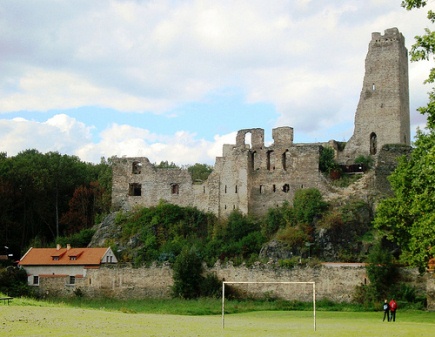

Location: 15 km (10 mi) North- West of Prague, Central Bohemian Region Map
Constructed: 1359 by Frantisek Rokyčansky
Okoř Castle, a striking medieval ruin perched on a rocky outcrop, stands as a testament to Czech history just outside Prague. Located in the village of Okoř in the Central Bohemian Region, it's approximately 15 kilometers (9 miles) northwest of the Czech capital, at coordinates 50°9′50.9″N 14°15′19.4″E. The site overlooks a verdant meadow and is easily accessible, about a 30-minute drive from Prague, making it a popular day-trip destination for history enthusiasts and tourists. Originally built as a fortress, it has evolved through multiple architectural phases before falling into disrepair, and today it hosts cultural events amid its atmospheric remnants.
The origins of Okoř Castle trace back to 1228, when a simple
stronghold was constructed in the small hamlet of Okoř. By 1359, it
was transformed into a full-fledged Gothic castle by František
Rokycanský, a prosperous burgher from Prague's Old Town, who
received the estate as a grant. Some accounts suggest it may have
been established slightly earlier in the first half of the 14th
century, possibly by Hynek Berka of Dubá, highlighting its strategic
importance during a period of feudal unrest.
The castle saw
significant changes under subsequent owners. The Lords of Donín
undertook Late Gothic remodelling, enhancing its fortifications. In
the second half of the 15th century, further extensions were added,
bolstering its defensive capabilities. By 1518, during the tenure of
Bořita of Martinice, it was converted into a more comfortable
Renaissance-style residence, reflecting the shifting needs from pure
defense to habitation.
The castle endured major turmoil during
the Thirty Years' War (1618–1648), suffering extensive damage from
battles and sieges. It was later restored in the Baroque style, but
its fortunes waned. In the 17th century, ownership passed to the
Jesuits, who maintained it until the order's suppression in Bohemia
in the late 18th century. Abandoned thereafter, the structure
gradually fell into ruin, with nature reclaiming parts of the site.
Despite some modern restoration efforts to stabilize the ruins, it
remains largely unrestored, preserving its romantic, decayed allure.
Throughout its history, Okoř played a role in regional power
dynamics, serving as a fortress during feudal conflicts and later as
a noble residence. Its decline mirrors broader shifts in European
military architecture and societal changes, from medieval warfare to
Enlightenment-era neglect.
Okoř Castle's architecture reflects its multi-phase evolution,
blending defensive functionality with later residential elements.
Initially constructed as a Gothic fortress in the 14th century, it
featured robust stone walls, a prominent central tower, and a layout
optimized for defense on its elevated rocky promontory. The core
structure includes a tall, slender bergfried (keep) that dominates the
skyline, surrounded by remnants of palace wings, bastions, and curtain
walls.
Late Gothic additions by the Lords of Donín introduced pointed
arches, vaulted interiors, and fortified gateways, enhancing its
resilience. The Renaissance conversion in 1518 added more ornate
elements, such as larger windows for light and comfort, transforming
parts into a livable chateau-like space. Post-Thirty Years' War Baroque
restorations included decorative flourishes, though much of this has
eroded.
Today, the ruins showcase exposed stone masonry, jagged wall
fragments with narrow slits for archers, and a moat-like depression
around the base. The site's natural integration with the basalt rock
formation adds to its dramatic appearance, with vegetation creeping over
the stones. While the Gothic core predominates in the surviving
elements, traces of later styles are visible in window frames and portal
designs.
In its present state, Okoř Castle is a well-preserved ruin, attracting visitors for its historical significance and scenic beauty. It's a favored spot for medieval reenactments, sword-fighting demonstrations, and festivals that bring its past to life. Access involves a short path from the village, with no formal parking lot but nearby options, and a small restaurant on-site for refreshments. The castle is open to the public, though some areas may be restricted due to ongoing stabilization work. Its proximity to Prague makes it ideal for cyclists or hikers, and it's often featured in films and photography for its evocative, leaning towers and panoramic views. As of 2025, it remains a symbol of Bohemia's medieval heritage, drawing crowds for both quiet exploration and lively events.